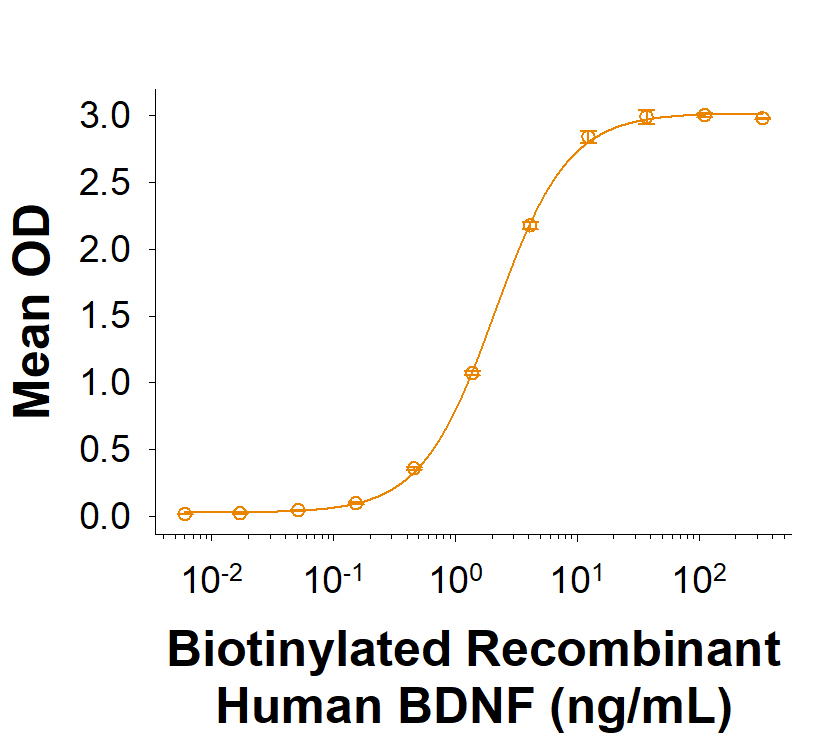Recombinant Human BDNF Biotinylated Protein, CF Summary
Product Specifications
His129-Arg247
Analysis
Product Datasheets
Carrier Free
CF stands for Carrier Free (CF). We typically add Bovine Serum Albumin (BSA) as a carrier protein to our recombinant proteins. Adding a carrier protein enhances protein stability, increases shelf-life, and allows the recombinant protein to be stored at a more dilute concentration. The carrier free version does not contain BSA.
In general, we advise purchasing the recombinant protein with BSA for use in cell or tissue culture, or as an ELISA standard. In contrast, the carrier free protein is recommended for applications, in which the presence of BSA could interfere.
BT11166
| Formulation | Lyophilized from a 0.2 μm filtered solution in PBS with Trehalose. |
| Reconstitution | Reconstitute at 100 μg/mL in PBS. |
| Shipping | The product is shipped at ambient temperature. Upon receipt, store it immediately at the temperature recommended below. |
| Stability & Storage: | Use a manual defrost freezer and avoid repeated freeze-thaw cycles.
|
Scientific Data
 View Larger
View Larger
Measured by its binding ability in a functional ELISA. When Recombinant Human TrkB Fc Chimera (688-TK) is immobilized at 0.5 μg/mL (100 μL/well), Biotinylated Recombinant Human BDNF Protein (Catalog # BT11166) binds with an ED50 of 1.00-10.0 ng/mL
Reconstitution Calculator
Background: BDNF
Brain-derived neurotrophic factor (BDNF) is a member of the neurotrophin family of growth factors that are required for the differentiation and survival of specific neuronal subpopulations in both the central as well as the peripheral nervous system. The neurotrophin family is comprised of at least four proteins including BDNF, nerve growth factor (NGF), neurotrophin-3 (NT3), and NT4/5. Human BDNF is initially expressed as a proprotein, which is then cleaved to yield a mature protein. Mature BDNF is a non-covalently linked homodimer, with each monomer containing antiparallel beta -strands and a characteristic cystine knot motif. Within the mature domain, human BDNF shares the identical amino acid sequence with mature mouse and rat BDNF. BDNF is strongly expressed in various regions of the brain, including the hippocampus and cerebellum, and weaker expression has been detected in the thymus, liver, spleen, heart, and lung. BDNF participates in axonal growth and pathfinding and in the modulation of dendritic growth and morphology and in later stages of development regulates synaptic transmission and plasticity and acts as a central modulator of pain. BDNF binds with high affinity and specifically activates the TrkB tyrosine kinase receptor. BDNF signaling via TrkB is essential for adult synaptic plasticity and the formation of memories. The BDNF signaling pathway utilizes both AKT and ERK pathways to exert its pleiotrophic effects in the central nervous system. Decreased expression of BDNF is seen in many neurological diseases such as Alzheimer's disease, Parkinson's disease, Huntington's disease, and autism. Further, BDNF is proposed as a biomarker for psychiatric disorders such as bipolar disease and depression and has been implicated in posttraumatic stress disorder, phobia, and panic disorder. A single amino acid substitution, Val66Met, has been shown to lead to reduced, activity-dependent BDNF secretion and memory impairment.
- Numakawa, T. et al. (2010) Histol. Histopathol. 25:237.
- Egan, M.F. et al. (2003) Cell 112:257.
- Pruunsild, P. et al. (2007) Genomics 90:397.
- Bathina, S. and Das, U.N. (2015) AMS 11:1164.
- Binder, D.K. and Scharfman, H.E.(2004) Growth Factors 22:123.
- Cattaneo, A. et al. (2016) Transl. Psychiatry 6:e958.
- Andero, R. et al. (2011) Am J. Psychiatry 168:163.
FAQs
No product specific FAQs exist for this product, however you may
View all Proteins and Enzyme FAQsReviews for Recombinant Human BDNF Biotinylated Protein, CF
There are currently no reviews for this product. Be the first to review Recombinant Human BDNF Biotinylated Protein, CF and earn rewards!
Have you used Recombinant Human BDNF Biotinylated Protein, CF?
Submit a review and receive an Amazon gift card.
$25/€18/£15/$25CAN/¥75 Yuan/¥2500 Yen for a review with an image
$10/€7/£6/$10 CAD/¥70 Yuan/¥1110 Yen for a review without an image


